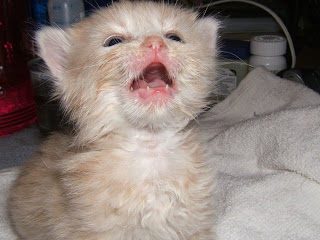
Total Protein... This is a measurement of the total protein in the blood. This test is important, but complex because it can indicate many different conditions.
The blood proteins are basically made up of two parts. These are albumin and globulin.
this test can indicate infection, swelling, pulmonary edema, ascities (abdominal fluid), kidney disease, liver disease, general nutritional health.
This test is also run in conjunction with the actual albumin and globulin values as well as the ratio of albumin to globulin.
This is an important set of tests in helping determine FIP.
There is a "test" for FIP and I'll discuss that later on in the blog. It is called an FIP Titre, but I personally think it is basically useless and a waste of money. (quick explaination for now, it that it only measures exposure to a corona virus not necessarily the fatal version that causes FIP and about 80% of all cats test positive. It has two results in standard lab testing >400 and >1600.)
So, looking at Zilla's test results, you will see that her Total Protein is High. Not what we'd like to see on lab work. Particularly if looking for FIP. But as I stated earlier, TP is indicative of many things, so again, it is the over all picture we have to take a look at.
I'll explain Albumin and Globulins further...but let's talk about what we did to treat Zilla at this point.
We started her on a course of Antibiotics and prednislone based upon both the lab results and her chest xrays (to be posted shortly). I should also add at this point, she was running a substancial fever 105-106%.
This set of labs was the point where the head and the heart split paths. It happens, I think in particular when you "know" the truth, but you don't want to face it, because the end result is terrible. I knew, and I know my vet knew, I don't remember exactly what he said, but I clearly remember thinking at the time, wow, he's trying to ease me into this.
So a quick note about my vet. One of the few good people. Loves animals, is caring and compassionate and a genuine nice person. I trust him with my pets, and that says a lot. Now, as he would no doubt sigh and tell you, it does not mean I won't totally research every little thing to death and back and argue with him and bug the crap out of him...and still want him to perform miracles for me. But those are my shortcomings, not his.
http://www.rbvhhillsborough.net/Having said that however and I can not emphasis this enough
YOU MUST ADVOCATE FOR YOUR PET and in order to do so, you must learn everything you can about what is wrong with them. you NEVER know when something small will make a huge difference. Education should never stop. It doesn't mean you need to go to back to school, there are terrific books out there to read.
I'll post a list of my favorites as time permits.
























